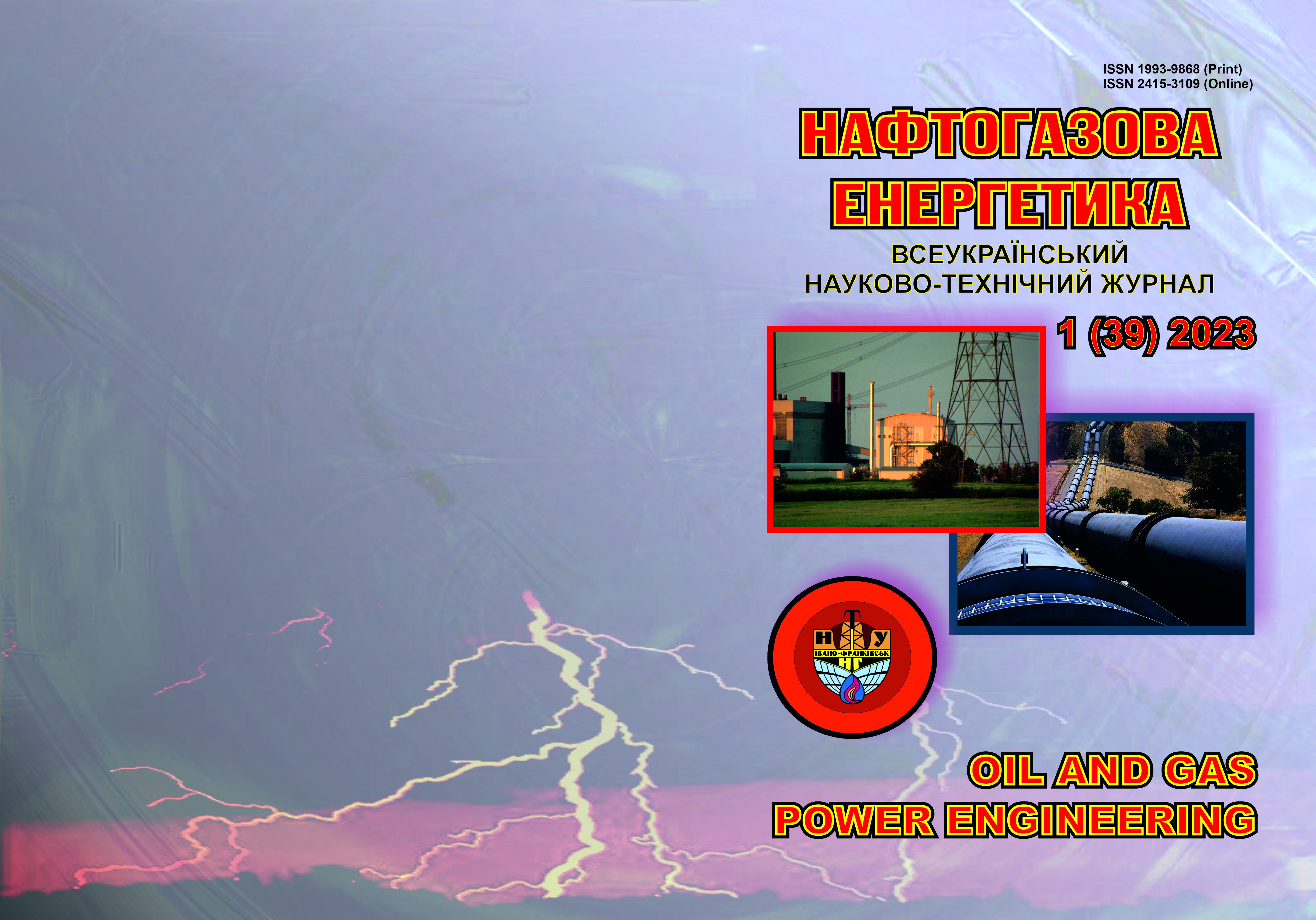EXPERIMENTAL LABORATORY STUDIES OF THE PROCESS OF RECEIVING HYDROGEN FROM FORMATION FLUIDS
DOI:
https://doi.org/10.31471/1993-9868-2023-1(39)-16-23Abstract
The article focuses attention on the necessity and possibilities of implementing the decarbonisation process in the oil and gas production sector, which over the last 250 years of operation in Ukraine has become both a source of the main energy supply of the state and a problem of serious emissions of greenhouse gases and pollution. Attention is concentrated on the fact that due to the aging of the oil and gas infrastructure and the continuity of hydrocarbon regeneration processes in the subsoil, there are threats of polluting substances emission into the atmosphere, which requires the search for effective solutions that could prevent this problem and be effective in the field of energy generation. In accordance with the relevance of the problem, the purpose of the scientific publication and research tasks have been formulated, which consist in creating a laboratory facility for thermobaric investigation; physical modelling of the process with the reproduction of the appropriate thermobaric conditions and the use of reservoir fluids of various composition; selection of optimal process parameters when assessing possible risks at various stages of its implementation. To implement the research objectives, the authors outlined an algorithm for the laboratory practical implementation of the process of thermobaric transformation of water-oil fluids in the created research facility, which allows us to approximately model the conditions of in-situ combustion. To evaluate the studied gas mixture, a series of analyses of known gases and their relative mixtures was conducted. At the same time, gas containers with methane, oxygen, a mixture of argon and hydrogen, oxygen and nitrogen were used, as well as carbon monoxide and hydrogen synthesized chemically under laboratory conditions. At a fixed temperature and pressure, the progress of the chemical reaction was monitored for a certain time, after which the obtained gas mixture was analysed using several approaches (chromatographic, chemical, cryogenic). On the basis of in-situ combustion physical modelling process of water-oil mixtures selected compositions with different concentrations of water and oil (20-70% of its volume) under the influence of appropriate thermobaric conditions (pressure 2-4 MPa and temperature 360 and 500 оС) for 50-60 minutes of conducting each of the experiments, the direct signs of hydrogen presence were found, which confirms the assumption about the possibility of obtaining it. In order to determine the quantitative indicators of obtaining hydrogen from water-oil mixtures during in-situ combustion, it is necessary to improve the design of the experimental facility and conduct additional studies for establishing the optimal parameters of the process while assessing possible risks at various stages of its implementation.
Downloads
References
Adegbesan K.O. Kinetic Study of Low Temperature Oxidation of Athabasca Bitumen: Ph.D. Thesis. Alberta: The University of Calga-ry, 1982.
Alberta Chamber of Resources. Oil Sand Technology Road Map. Edmonton, 2004.
Belgrave J.D.M., Moore R.G., Ursenbach M.G., Bennion D.W. A Comprehensive Ap-proach to In-Situ Combustion Modeling, SPE Advanced Technology Series, 1990. Vol. 1, No. 1. P. 98-107.
Babushok V.I., Dakdancha A.N. Global Kinetic Parameters for High-Temperature Gas-Phase Reactions. Combustion, Explosion, and Shock Waves, 1993, Vol. 29, P. 464-489.
Canadian Hydrogen Association. Hydro-gen Systems, 2004.
Davis B.E., Jennings J.W. State-of-the-Art Summary for Underground Coal Gasifica-tion, Journal of Petroleum Technology, 15-21, January 1984.
Energy Resources Conservation Board. Alberta’s Energy Reserves 2007 and Sup-ply/Demand Outlook 2008-2017. ST98-2008.
Fogler H.S. Elements of Chemical Reac-tion Engineering, Prentice Hall International Se-ries in the Physical and Chemical Engineering Sciences, 4th Edition, 2006.
Guntermann K., Gudenau H.W., Mohtadi M. Mathematical Modeling of the In Situ Coal Gasification Process, Eighth Underground Coal Conversion Symposium, August 1982, P. 297-306.
Hallam R.J., Hajdo L.E., Donnelly J.K., Baron R.P. Thermal Recovery of Bitumen at Wolf Lake, SPE Reservoir Engineering, May 1989, P. 178-186. URL: http://onepetro.org/SPEEURO/proceedings-pdf/09EURO/All-09EURO/SPE-122028-MS/1787188/spe-122028-ms.pdf
Hayashitani M., Bennion D.W., Don-nelly J.K., Moore R.G. Thermal Cracking of Athabasca Bitumen, The Future of Heavy Crude and Tar Sands: Second International Unitar Conference. Venezuela, 1977, P. 233-247.
Hayashitani M. Thermal Cracking of Athabasca Bitumen, Ph.D. Thesis. Alberta: The University of Calgary, 1978.
Hyne J.B., Greidanus J.W., Tyrer J.D., Verona D., Rizek C., Clark P.D., Clark R.A., Koo J. Aquathermolysis of Heavy Oils. The Fu-ture of Heavy Crude and Tar Sands: Second International Unitar Conference. Venezuela, 1977. P. 404-411.
Martin W.L., Alexander J.D., Dew J.N. Process Variables of In Situ Combustion. Petro-leum Transactions, AIME, SPE 914-G, 1958,
Vol. 213. P. 28-35.
Moore R.G., Laureshen C.J., Mehta S.A., Ursenbach M.G. Observations and Design Considerations for In Situ Combustion Projects. Journal of Canadian Petroleum Technology, 1999, Vol. 38, No. 13, P. 1-9.
National Research Council and Nation-al Academy of Engineering. The Hydrogen Economy. Washington, D.C.: The National Academies Press, 2004.
Rostrup-Nielsen J.R. Production of Synthesis Gas. Catalysis Today, 1993, Vol. 18, P. 305-324.
Scholz W.H. Processes for Industrial Production of Hydrogen and Associated Envi-ronmental Effects. Gas Separation & Purifica-tion, 1993, Vol. 7, No. 3, P. 131-139.
Yang X., Gates I.D. Combustion Kinet-ics of Athabasca Bitumen from 1D Tube Exper-iments. Natural Resources Research, 2009. URL: http://onepetro.org/SPEEURO/pro.
SPE 122028 Potential for Hydrogen Generation during In-Situ Combustion of Bitumen by Punitkumar Ramanlal Kapadia, Michael Kallos, Leskiw Chris, and Ian Donald Gates, SPE, University of Calgary.
WO2017136924 – In-situ process to produce hydrogen from underground hydrocarbon reservoirs.
Downloads
Published
How to Cite
Issue
Section
License
Copyright (c) 2023 Oil and Gas Power Engineering

This work is licensed under a Creative Commons Attribution-ShareAlike 4.0 International License.


.png)






1.png)









